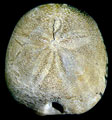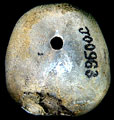Kier (1962, p. 78) stated that Asterobrissus fourtaui Lambert, in Demoly, 1913, has been incorrectly designated the type species. This is because this species was not included among those referred to Trochalia in Pomel\'s original description of the genus, or in de Loriol\'s later description of Asterobrissus. Kier (1962, p. 78) therefore designated Echinobrissus requieni Desor in Agassiz & Desor, 1847 as the type species.
Kier (1962, p. 78) considers Asterobrissus to be a subjective junior synonym of Phyllobrissus as the type species are very similar. Both have a similar petal arrangement, a tetrabasal apical system, supramarginal periproct that is close to the margin, and double-pored phyllodes with no buccal pores. He points out that Asterobrissus differs mainly in shape, being almost square in marginal outline, but believes that this difference is not of sufficient importance to warrant generic distinction.
P. M. Kier. 1962. Revision of the cassiduloid echinoids. Smithsonian Miscellaneous Collections, 144 (3) 262 pp.
J. Lambert & P. Thiery. 1909-1925. Essai de nomenclature raisonnee des echinides. Libraire Septime Ferriere, Chaumont, 607 pp., 15 pls.




